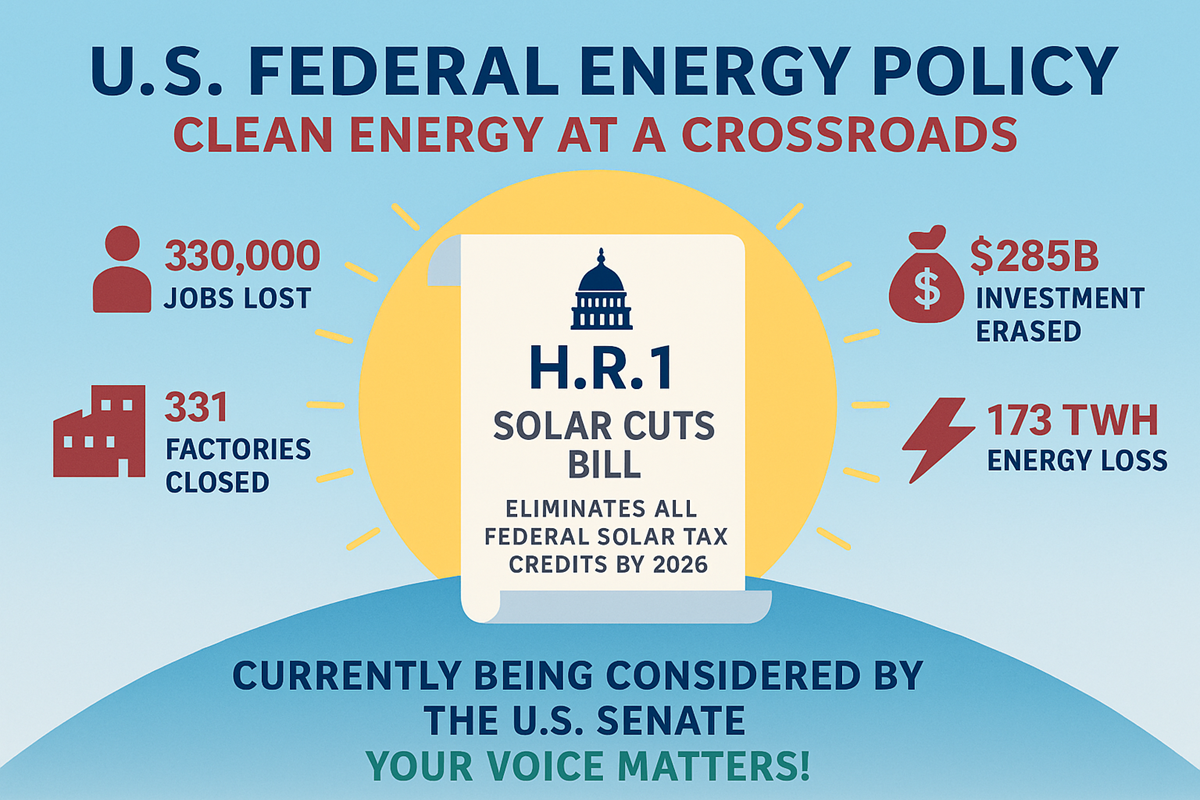Killing Off Renewables’ Solar Tax Credit Makes No Sense: What’s at Stake for America?
🏡️ What Is the “One Big Beautiful Bill”?
On May 22, 2025, the U.S. House of Representatives passed H.R. 1, formally titled the One Big Beautiful Bill Act. While the name may sound grand, buried deep within this sweeping legislation is one of the most consequential reversals of energy policy in U.S. history: the complete elimination of all federal solar tax credits beginning in 2026.
The bill has already cleared the House. Now, it’s up to the U.S. Senate to decide whether to uphold or undo this massive setback to America’s clean energy momentum.
💡 What Solar Incentives Will Be Eliminated?
If enacted, the legislation will dismantle both residential and commercial solar incentives that have helped make renewable energy more accessible and affordable nationwide:
- Residential Solar Tax Credit (Section 25D): Ends entirely for any system purchased after December 31, 2025.
- Commercial Solar Tax Credit (Section 48E): Will only apply to projects with a down payment made within 60 days of the bill’s signing (expected by October 2025). Installations must be completed by December 31, 2028.
- After 2028: All federal tax credits for solar and battery storage will cease to exist.
⚠️ What Are the Economic Risks?
Economists and energy analysts warn that these policy rollbacks could trigger a devastating ripple effect throughout the U.S. economy. Not only would households and businesses face higher electricity costs, but critical industries and job sectors could be hit hard.
Here’s what’s at stake:
- 330,000 jobs lost, primarily in skilled trades and clean energy construction
- 331 clean tech factories closed or canceled
- $285 billion in local investment erased
- $51 billion in added electricity costs for consumers
- 173 TWh of energy supply lost—enough to threaten grid reliability in high-demand states
🔌 Why Clean Energy Matters Now More Than Ever
The timing of this bill couldn’t be worse. The U.S. power grid is under unprecedented strain due to the rise of artificial intelligence, data centers, electric vehicles, and manufacturing reshoring. These energy-hungry sectors require stable, affordable power.
Solar and battery storage are not only the fastest-growing energy sources—they’re now the cheapest. Dismantling support for them would push us backward, forcing a return to costly fossil fuel infrastructure that takes longer to deploy and is more vulnerable to market volatility.
🌍 Global Leadership and the Paris Agreement
This legislation also represents a retreat from the international stage. Under the Paris Climate Agreement, the U.S. has encouraged voluntary efforts by states, cities, and industries to lower emissions and accelerate the clean energy transition.
Reversing solar incentives sends the opposite message: that America is choosing outdated energy models over future-focused innovation. Meanwhile, other nations—like China, Germany, and Spain—are rapidly scaling up clean energy investments, seizing leadership in the global race for sustainable technology.
🗳️ Do Americans Support Solar?
The short answer: yes. This is not a fringe issue—it’s mainstream, popular, and bipartisan. Across the country, Americans consistently express strong support for solar power and clean energy policies:
- 87% support solar energy
- 75% support federal clean energy incentives
- 74% believe solar benefits the U.S. economy
- 71% agree solar will help families save money
- A majority believe solar plus battery storage improves grid reliability
This strong public consensus stands in sharp contrast to the direction of the proposed legislation.
❌ Don’t Buy the Misinformation
Some utility companies and fossil fuel advocates have been quick to spread outdated talking points—chief among them is the myth of “intermittency.” The argument goes like this: solar and wind can’t be relied upon because they don’t produce power 24/7. But that oversimplification ignores decades of advancement and data.
The truth is: solar generates most of its electricity during the day—exactly when it’s most needed. From air conditioning in the summer to peak-hour commercial demand, daytime generation aligns with daytime consumption. And because solar energy flows to the nearest available need, your neighbor’s rooftop panel can help power your home, school, or business.
Battery storage, once a barrier, is now a solution. Modern battery systems stabilize the grid by storing excess energy during the day and releasing it when demand spikes. Combined with smart grid technologies, these tools enhance reliability at both local and national scales.
You may also hear critics say that solar needs to “stand on its own feet”—that it’s time to end subsidies. In fact, solar is standing—stronger than ever. But let’s be honest: fossil fuels like oil, coal, and gas still receive massive direct and indirect subsidies. Despite being 150-year-old industries, they continue to benefit from tax breaks, drilling incentives, and legacy infrastructure support.
Meanwhile, renewables and energy efficiency receive only a fraction of those supports, despite being newer, cleaner, and more aligned with future needs. If solar is an adult industry, then so are fossil fuels—but one is renewable and sustainable. The other is not.
🧱️ Why the Senate Must Stop This Bill
At this stage, the U.S. Senate is the final backstop. Senators must recognize that this isn’t just an energy policy decision—it’s a strategic choice about national priorities.
Passing this bill would:
- Stall job growth in one of America’s fastest-growing sectors
- Disrupt billions in private and public clean tech investment
- Increase electric bills for consumers and small businesses
- Hand strategic energy leadership to foreign competitors
If it becomes law, we don’t just lose solar incentives—we lose time, momentum, and our edge in the global clean energy race.
♻️ So What’s the Logic?
It’s worth asking: If renewables are cheaper, faster to deploy, crucial to energy independence, and key to climate leadership—then why are we working to dismantle our own advantage?
This is no longer about left vs. right. It’s about forward vs. backward. Every year of delay puts us further behind countries investing in a cleaner, smarter energy future.
Here is a facts sheet about Federal Renewable Energy Policy (Doc).
Other Pi-Sustain (SustainZine) Blog posts.
📣 Take Action Now
The U.S. Senate is debating this bill right now. If you believe in affordable energy, job creation, and American innovation, now is the time to speak up.
👉 Contact your Senators here: www.senate.gov/senators/senators-contact.htm
CleanEnergy #SolarPower #EnergyPolicy #HR1Bill #ClimateAction #USSenate #GreenJobs #BatteryStorage #SubsidyShift #EconomicDevelopment #SustainZine #PerpetualInnovation #PiSustain
📄 GenAI Disclosure
This article was drafted with the assistance of ChatGPT-4o (OpenAI) and Gemini 2.5 Flash (Google) for writing and refinement. The author developed the original outline, conducted all fact-checking, and finalized the content. AI-generated material was used under human direction and reviewed for accuracy. Tools accessed June 17, 2025.


